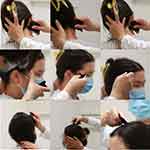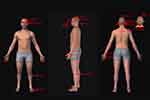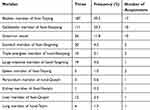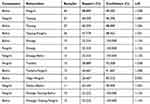Back to Journals » Journal of Pain Research » Volume 17
Analysis of Acupoint Selection Rules for Guasha Treatment of Primary Headaches Based on Data Mining
Authors Zhang X, Huang X , Ni F, Mao X, Yang D, Xu M
Received 6 December 2023
Accepted for publication 2 March 2024
Published 9 April 2024 Volume 2024:17 Pages 1393—1400
DOI https://doi.org/10.2147/JPR.S453671
Checked for plagiarism Yes
Review by Single anonymous peer review
Peer reviewer comments 2
Editor who approved publication: Dr Houman Danesh
Xujie Zhang, Xinrui Huang, Feilin Ni, Xiaopei Mao, Danhua Yang, Min Xu
Department of Nursing, The First Affiliated Hospital of Zhejiang Chinese Medical University (Zhejiang Provincial Hospital of Chinese Medicine), Hangzhou, Zhejiang, 310003, People’s Republic of China
Correspondence: Min Xu, Department of Nursing, The First Affiliated Hospital of Zhejiang Chinese Medical University (Zhejiang Provincial Hospital of Chinese Medicine), No. 54, Youdian Road, Hangzhou, Zhejiang, 310003, People’s Republic of China, Email [email protected]
Objective: We aimed to understand the commonly used acupoints and the acupoint combination rules in Guasha therapy for primary headaches using data mining technology, providing a reference for the clinical application of Guasha therapy for primary headaches.
Methods: Literature related to Guasha therapy for primary headaches in PubMed, Web of Science, Chinese National Knowledge Infrastructure, Wanfang Data Knowledge Service Platform, and Chinese Biomedical Literature Database were searched, up until May 12, 2023. A database of acupoints for Guasha therapy for primary headaches was established in Excel. The frequency of the acupoints used for Guasha in therapy of primary headaches were calculated by SPSS 25.0. The association rules between the acupoints were further described using SPSS Modeler 18.0.
Results: A total of 67 papers were included, involving 51 acupoints for Guasha against primary headaches. The most commonly used acupoints were Fengchi, Baihui, Taiyang, Shuaigu, Tianzhu, and Hegu. The common acupoint combinations for Guasha therapy for primary headaches were Fengchi-Taiyang, Fengchi-Baihui, Fengchi-Taiyang-Baihui, Fengchi-Tianzhu-Baihui, and Fengchi-Shuaigu-Taiyang-Baihui.
Conclusion: Data mining can effectively analyze the commonly used acupoints and the acupoint combination rules in Guasha therapy for primary headaches, providing a reliable basis for clinical acupoint selection.
Keywords: primary headache, Guasha, data mining, acupoint selection rules, Chinese medicine nursing
Introduction
The International Headache Society (IHS) categorizes headaches into Primary and Secondary headaches.1 The prevalence of primary headaches in China is approximately 23.8%, among which tension-type headaches (10.8%) and migraine (9.3%) are the most common.2,3 In the field of traditional Chinese medicine (TCM), primary headache falls into the categories of “headwind (Tou Feng in Chinese)” and “brain wind (Nao Feng in Chinese)”. When it occurs, the headache symptoms can last for 7–15 days and may be accompanied by symptoms such as nausea, vomiting, photophobia, and pericranial muscle tension. Some patients may even progress to chronic primary headaches, prone to concurrent complications, leading to the complexity of the disease. Current treatments often include symptomatic treatment, such as oral analgesics. However, the efficacy of oral analgesics is not significant, and long-term use of analgesics can produce drug side effects and drug dependence. Moreover, inadequate medical resources for headache and over-the-counter (OTC) medicine use may result in medication-overuse headache and chronic migraine development.4,5
Guasha is a surface-stimulating therapy to prevent and treat diseases based on the theory of meridians and acupoints in TCM, using specially made Guasha tools to scrape the body surface with appropriate techniques,6,7 as illustrated in Figure 1. As an important non-pharmaceutical treatment, Guasha is safe, effective, easy to operate, and has minimal side effects. Existing research has confirmed that Guasha therapy has significant effects in treating primary headaches, but the selection of acupoints for Guasha therapy for primary headaches currently varies widely, and its standardization and scientific validity need further improvement.
 |
Figure 1 Guasha. |
This study aims to summarize the selection rules for acupoints in Guasha therapy for primary headaches based on data mining analysis, in order to provide a reference for clinical treatment of Guasha.
Materials and Methods
Literature Search Strategy
We searched the Chinese National Knowledge Infrastructure (CNKI, https://www.cnki.net), Wanfang Data Knowledge Service Platform (http://www.wanfangdata.com.cn), Chinese Biomedical Literature Database (www.sinomed.ac.cn/index.jsp), PubMed (https://pubmed.ncbi.nlm.nih.gov), and Web of Science (http://www.webodscience.com/wos/woscc/basic-search) databases. Languages were limited to Chinese and English, with a search timeframe from the inception of each database to May 12, 2023. The English search terms were “gua sha/guasha/scrapping the therapy” and “primary headache/migraine/hemicrania/sick headache/megrim/cephalalgia”. In the Chinese database search, the medical subject terms matched the Chinese translations found in medical subject headings, focusing on Guasha and headache.
Literature Inclusion and Exclusion Criteria
Inclusion criteria: (i) Clinical studies of Guasha interventions for primary headache; (ii) the intervention method was Guasha or Guasha in combination with other interventions.
Exclusion criteria: (i) Conference papers, reviews, scientific and technological achievements, animal experiments, mechanistic studies, and Meta-analyses; (ii) studies that did not clearly state the acupoints for Guasha; (iii) duplicate publications.
Literature Quality Assessment
The Joanna Briggs Institute (JBI) Evidence-Based Healthcare Centre’s 2016 edition of the assessment tool was used, with the quality assessment criteria being selected according to the type of literature. Two researchers independently performed the initial literature screening. Endnote was used to de-duplicate and organize the literature that met the requirements, and the literature was further read in-depth. Literature that did not meet the inclusion and exclusion criteria was excluded. In case of disagreement, the third researcher, an expert with over 20 years of experience in the field of TCM nursing and who is well-versed in evidence-based nursing, was consulted for decision-making. When the conclusions of different evidence were contradictory or inconsistent, the most recently published authoritative literature was given priority.
Statistical Analysis
The acupoint names were standardized according to the national standard “Nomenclature and location of meridian points” (GB/T 12346–2021).8 Information on the differentiation of symptoms and signs of primary headache, the names of acupoints, and their frequency of use were extracted from the screened literature, and the data was entered into Excel. Data preprocessing was carried out, including eliminating duplicate items, transforming the data into Boolean data, eliminating noise data, and processing data consistency. SPSS Modeler 18.0 was used for data mining, and an association rule mining model based on the Apriori algorithm was established to analyze the acupoint prescription. “X” was set as the antecedent and “Y” as the consequent. The minimum support and confidence were determined based on the volume and attributes of the preprocessed data, and the rules were sorted by “support”. Association rules with confidence ≥ 80%, support > 20%, and lift > 1 were selected.
Results
Literature Screening results
A total of 481 literatures were retrieved, and 302 remained after duplicates were removed. After excluding reviews, systematic evaluations, conference papers, scientific and technological achievements, and literature for which full text could not be obtained, 86 literatures remained. After reading the full texts and excluding content that did not meet the requirements, 67 pieces were finally remained, including 55 pilot studies, 11 empirical reports, and 1 case report. The flow chart of literature screening is shown in Figure 2.
 |
Figure 2 Fow chart of literature screening. |
Quality Evaluation results of the Included Literature
According to the evaluation criteria, the quality of the included literature was evaluated. Among the 55 pilot studies, 19 were rated as Grade A (strongly recommended), and 36 were rated as Grade B (weakly recommended). Among the 11 empirical reports, 4 were rated as Grade A and the other 7 as Grade B. The case report was rated as Grade A. The included literatures had a relatively complete research design and high overall quality and were all approved for inclusion.
Frequency Analysis of Acupoints
A total of 51 acupoints were used in 67 literatures, with a usage frequency of 476 times. The most frequently used acupoints in sequence were Fengchi, Baihui, Taiyang, Shuigou, Tianzhu, and Hegu. The details were shown in Table 1 and Figure 3.
 |
Table 1 Statistical Table of Acupoint Locations with Use Frequency ≥ 5 Times |
 |
Figure 3 Acupoints schematic diagram. |
Frequency Analysis of Meridians
The acupoints in the included literature involved 11 meridians, with the bladder meridian of foot-Taiyang being the most frequently used, followed by the gallbladder meridian of foot-Shaoyang and governor vessel, as shown in Table 2. The frequency of the Ah Shi acupoint was 6, accounting for 1.3%; the frequency of the Taiyang acupoint was 40, accounting for 8.4%. Since the Ah Shi acupoint is an undefined acupoint that varies with the disease, and the Taiyang acupoint is not located on a meridian, these two acupoints were not shown in Table 2.
 |
Table 2 Meridian Statistics of Guasha Therapy for Primary Headache |
Analysis of Acupoint Association Rules
The 51 acupoints appearing in the 67 literatures were analyzed for association rules, and the acupoint compatibility relationship of Guasha treatment for primary headache was explored using SPSS Modeler 18.0. The acupoints used in pairs were: Fengchi-Taiyang acupoint, Fengchi -Baihui acupoint, and Baihui-Taiyang acupoint; the acupoints used in triples were: Fengchi-Taiyang-Baihui acupoint, Fengchi-Tianzhu-Baihui acupoint, and Fengchi-Shuigou-Baihui acupoint; the acupoints used in fours were: Fengchi-Shuigou-Taiyang-Baihui acupoint and Baihui-Taiyang-Fengchi-Tianzhu acupoint. The strong association rules of Guasha for primary headaches were represented in Table 3.
 |
Table 3 Strong Association Rules of Scraping Therapy for Primary Headache |
Discussion
Modern medicine believes that the pathogenesis of headaches is related to many factors, such as insufficient cerebral vascular hemodynamics, formation of microvessels, regulation of the central nervous system function of blood vessels, and cerebral vasospasm. In the field of TCM, the therapy of headaches mainly contains herbal medicine,9 acupuncture,10 and Guasha. Guasha therapy increases skin temperature and blood perfusion, causing congestion and bleeding in the subcutaneous vessels, generating “Sha” as a source of stimulation, activating various signaling pathways, producing biological effects, and achieving pain relief.11 Research has shown that Guasha has anti-inflammatory, antioxidant, and neuroregulatory effects.12 Data mining results in this study revealed that the acupoints for treating primary headaches are mostly distributed on the face and head, mainly the Fengchi, Baihui, and Taiyang acupoints. These three acupoints have a total frequency of 160 times, accounting for 33.6% of the total frequency of acupoints. Studies believe that the subcutaneous area of the Fengchi acupoint is distributed with sensory nerves such as the lesser occipital nerve andthe third cervical nerve, the nerve endings of which are distributed to the lateral skin of the head, behind the auricle, and the lateral skin of the occipital.13,14 Intervention on the Fengchi acupoint can control the sensory conduction of the side of the head. Liu et al have clarified the effectiveness of the Fengchi acupoint in reducing headaches by combining various intrinsic mechanisms with empirical evidence.13 The nature of the Baihui acupoint is Yang, yet it contains Yin within Yang, so it can connect with the Yin and Yang meridians and coordinate all the acupoints. Guasha at the Baihui acupoint has a brain-protecting function. It can promote the blood flow velocity of the right posterior cerebral artery, inhibit adhesion molecules expression on the vascular endothelial cell surface, reduce leukocyte adhesion and infiltration, and alleviate the damage of inflammatory mediators to brain tissue.15 The Taiyang acupoint is an extra meridian acupoint, and Guasha at this point has the effect of clearing heat, reducing swelling, relieving pain, and relaxing the collaterals.16
At the same time, association rule analysis found that the combinations with higher confidence in Guasha therapy for primary headaches are Baihui-Fengchi acupoint, Fengchi-Taiyang acupoint, Fengchi-Taiyang-Baihui acupoint, Fengchi-Shuaigu-Taiyang-Baihui acupoint, and so on. Acupoint compatibility refers to the application of two or more acupoints with a synergistic effect, which complement each other and enhance the intervention effect.17 The combinations of acupoints with higher confidence in compatibility have a significant synergistic effect, and the synergy of acupoints can promote the circulation of Qi and blood, expel external wind (Wai feng), and thus improve the treatment effect on primary headaches.
Moreover, the acupoints of Guasha intervention for primary headaches also involved the limbs and neck, and shoulders. However, the number and total frequency of acupoints were relatively less than those on the head and face. Although different acupoints are distributed in different parts of the body, many are located on the same meridian. The meridians chosen for Guasha therapy for primary headaches are mainly the bladder meridian of foot-Taiyang, the gallbladder meridian of foot-Shaoyang, and governor vessel, accounting for 74.4%. Therefore, the choice of meridians in Guasha treatment for primary headaches shows high homogeneity. The bladder meridian of foot-Taiyang is connected to the brain through the collaterals at the top of the head. The bladder meridian of foot-Taiyang starts from the inner canthus of the eye, which is also the starting point of a branch of governor vessel. It can enter the skull along the bladder meridian to connect to the brain, strengthening the connection between the bladder meridian and the brain, both of which participate in the regulation of the brain spirit.18 The pathogenesis of headache on the gallbladder meridian of foot-Shaoyang is kidney weakness, a disorder of Qi in the middle Jiao, and liver Qi stagnation causing an ascendant liver fire (liver huo). The gallbladder meridian of foot-Shaoyang passes through both sides of the head and connects to the ear.19 The gallbladder meridian of foot-Shaoyang is a hub for the transmission of Yin and Yang Qi inside and outside. Healthcare professionals should fully recognize the importance of meridians and viscera in the operation of the human body to scientifically select suitable meridians and acupoints. The “Classic of Questioning·28 question” states: “Governor vessel. goes up to the wind mansion and enters the brain”. The governor vessel runs at the back of the human body, going up along the spine, integrating the functions of the heart, brain, and kidneys through its circulation.20,21 “The governor vessel is also the place where the brain and spinal nerves are located”, and there has been a saying since modern times that “if the disease is in the brain, first take governor vessel”.22 Therefore, the bladder meridian of foot-Taiyang, the gallbladder meridian of foot-Shaoyang, and governor vessel are of great significance in the treatment of primary headaches. Healthcare professionals need to be familiar with the related theories of meridians and can reasonably choose the meridians and their acupoints according to the specific symptoms of patients with primary headaches.
In conclusion, this article analyzed the commonly used acupoints, acupoint combination rules, and the meridians where the common acupoints are located in Guasha treatment for primary headaches using data mining technology. In summary, the feasibility of data mining for acupoint selection rules in Guasha treatment for primary headaches can provide corresponding data support for the clinical treatment of primary headaches. Due to the relatively small number of studies, this research did not further compare Guasha treatments for different types of primary headaches. Future work can focus on clinical trials of Guasha interventions for common primary headaches such as migraines and tension headaches, to explore the differences in acupoint selection among different types of primary headaches, thereby further enhancing the effectiveness of TCM nursing care.
Funding
This work was supported by [Zhejiang Province Chinese Medicine Scientific Research Fund Project] [number 2021ZA055], [Zhejiang Province Science and Technology Plan Project] [number 2023C03165].
Disclosure
The authors have no conflicts of interest to declare in this work.
References
1. Olesen J. International Classification of Headache Disorders. Lancet Neurol. 2018;17(5):396–397. doi:10.1016/S1474-4422(18)30085-1
2. Ge R, Chang J. Disease burden of migraine and tension-type headache in non-high-income East and Southeast Asia from 1990 to 2019. j Headache Pain. 2023;24(1):32. doi:10.1186/s10194-023-01566-5
3. Peng KP, Wang SJ. Epidemiology of headache disorders in the Asia-pacific region. Headache. 2014;54(4):610–618. doi:10.1111/head.12328
4. Carlsen LN, Westergaard ML, Bisgaard M, Schytz JB, Jensen RH. National awareness campaign to prevent medication-overuse headache in Denmark. Cephalalgia. 2018;38(7):1316–1325. doi:10.1177/0333102417736898
5. Katsuki M, Matsumori Y, Kawahara J, et al. Headache education by leaflet distribution during COVID-19 vaccination and school-based on-demand e-learning: itoigawa Geopark Headache Awareness Campaign. Headache. 2023;63(3):429–440. doi:10.1111/head.14472
6. Institute of Acupuncture and Moxibustion C Standardized manipulations of acupuncture and moxibustion Part 22: guasha therapy. In.
7. Wang A, Ji B, Yang A, Yang A, Xu A, Yang A. Study on scraping along meridians. J Basic Chine Med. 2021;27(03):527–530.
8. Institute of Acupuncture and Moxibustion C Nomenclature and location of Meridian points. In.
9. Katsuki M, Kashiwagi K, Kawamura S, Koh A. The Efficacy of Japanese Herbal Kampo Medicine as an Acute and Prophylactic Medication to Treat Chronic Daily Headache and Medication Overuse Headache:-Single Arm Retrospective Study. Cureus. 2022;14(5):56.
10. Ishiyama S, Shibata Y, Ayuzawa S, Matsushita A, Matsumura A, Ishikawa E. The Modifying of Functional Connectivity Induced by Peripheral Nerve Field Stimulation using Electroacupuncture for Migraine: a Prospective Clinical Study. Pain Medicine. 2022;23(9):1560–1569. doi:10.1093/pm/pnac048
11. Wang A, Yang A. Compilation of Scraping Syndrome Literature and Modern Research on Scraping. China Medical Sciience Press; 2015.
12. Wu A, Liu A, et al. Study on immunological components and their contents in subcutaneous exudate induced by cutaneous scraping method. J Guangzhou Univ Trad Med. 2017;34(02):209–212.
13. Liu A, Lu A. Correlation between migraine and action mechanism of GB20. Acta Chine Med Pharmacol. 2023;51(03):51–55.
14. Wang A. Pathways dissection and mechanism of Fengchi acupuncture point. Traditional Chine Med Res. 2010;23(01):68–70.
15. Ma A, Kong B, Qi C, Shen B, Ma A. Ancient and modern reaearch on role of Baihui to brain. Liaoning J Traditional Chine Med. 2019;46(2):425–428.
16. Dong ZA, Zhang A, Cui B, Zhang A, Zhang A. Clinical study on collateral bloodletting at Taiyang point combined with acupuncture for headache with excess syndrome. N Chine Med. 2022;54(20):3.
17. Huang A, Ma A, Gu C. Analysis of dialectical acupoint selection rules of acupoint massage in treatment of insomnia. Chine J Nursing. 2021;56(3):404–408.
18. Wang A, Zhang A, Liu A, Tang B. Correlation between the Wuzangshen and the bladder Meridian of foot-Taiyang. Journal of Anhui Traditional Chinese Medical College. 2021;40(1):7–9.
19. Yu X, Jiang A, Ma A, Chi CL, Zhang A, Liu A. Acupoint selection regularity of acupuncture and moxibustion in treating menstrual headache based on data mining. J Shandong Univ Traditional Chine Med. 2021;45(3):347–353.
20. Wang A, Zhou A, Shi A. Clinical Study on Acupuncture at Governor Vessel and Beishu Points Combined with Moxibustion with Seed-Sized Moxa Cone for Migraine Without Aura with Syndrome of Upward Harassment of Phlegm Turbidity. N Chine Med. 2023;55(10):117–121.
21. Zhang A, Zhang A, Shao A, An C, Jia C, Liu A. Acupoint Selection Rules in Treating Tension Type Headache with Acupuncture and Moxibustion on Data Mining. J Yunnan Univ Chine Med. 2021;44(4):47–51.
22. Wang A, Wang A, Wu A. Exploration of Tongdu Tiaoshen Acupuncture Treating Cervicogenic Headache. Clin J Traditional Chine Med. 2020;32(12):2199–2202.
 © 2024 The Author(s). This work is published and licensed by Dove Medical Press Limited. The full terms of this license are available at https://www.dovepress.com/terms.php and incorporate the Creative Commons Attribution - Non Commercial (unported, v3.0) License.
By accessing the work you hereby accept the Terms. Non-commercial uses of the work are permitted without any further permission from Dove Medical Press Limited, provided the work is properly attributed. For permission for commercial use of this work, please see paragraphs 4.2 and 5 of our Terms.
© 2024 The Author(s). This work is published and licensed by Dove Medical Press Limited. The full terms of this license are available at https://www.dovepress.com/terms.php and incorporate the Creative Commons Attribution - Non Commercial (unported, v3.0) License.
By accessing the work you hereby accept the Terms. Non-commercial uses of the work are permitted without any further permission from Dove Medical Press Limited, provided the work is properly attributed. For permission for commercial use of this work, please see paragraphs 4.2 and 5 of our Terms.
